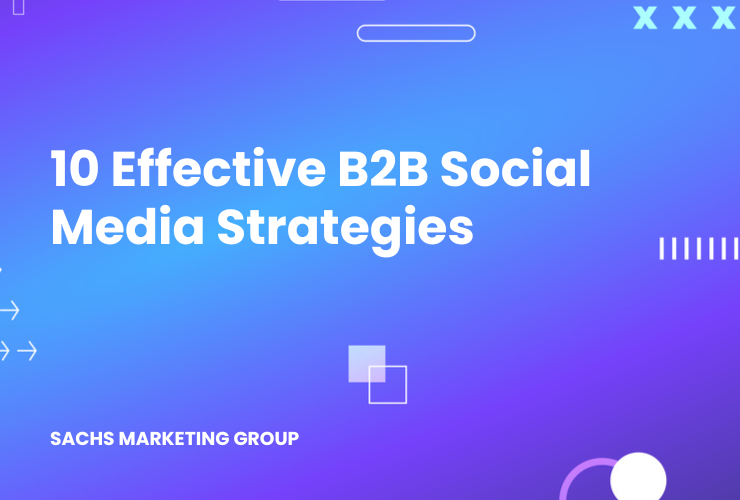B2B social media strategies are essential for connecting with other businesses and professionals. They involve targeted content, networking, and engagement approaches tailored to business clients’ unique needs and behaviors.
Do you need help to make an impact on social media marketing in the B2B space?
You’re not alone. It’s a challenging arena, but with the right strategies, you can capture the attention of business clients and build meaningful connections.
In this article, we’re exploring 10 effective B2B social media strategies that can help drive results.
B2B Social Media Strategies
In the B2B world, social media is more than just a tool for outreach – it’s a platform for building relationships, establishing thought leadership, and driving business growth.
Effective social media marketing strategies blend content creation, audience understanding, and measurable goals.
Here are seven effective B2B social media strategies to consider.
1. Understand Your Audience
In B2B social media marketing, understanding your audience is more than knowing their industry. It’s about diving deep into their business challenges, preferences, and behaviors.
Start by developing detailed buyer personas, including job roles, pain points, goals, and information consumption habits. Research what topics they engage with most, the type of content they prefer (like short-form videos, articles, or infographics), and their active hours on social media.
Engagement analytics can provide insights into what content resonates with them. Also, consider their decision-making process and who influences these decisions.
By understanding these aspects, you can tailor your content to their needs and interests, making your social media efforts more relevant and impactful.
Your audience is looking for solutions and expertise. Your content should position your brand as an expert who understands and can meet their unique business needs.
2. Analyze the Competition’s Activity
Analyzing your competition’s social media activity is vital for gaining a competitive edge.
Start by identifying your main competitors and analyzing their social media presence. Look at the platforms they are active on, the frequency of their posts, the type of content they share, and how they engage with their audience.
Pay attention to their most successful posts – what topics do they cover, and what kind of response do they receive? Analyzing this can help you identify what resonates with your shared audience. Also, note any gaps in their strategy that you can capitalize on. For instance, if they are strong on LinkedIn but weak on X, you might find an opportunity to engage your audience on the less saturated platform.
Monitoring competitor activity should be an ongoing process, as it can provide continuous insights and inspiration for refining your social media strategy.
Check this out: How to Use LinkedIn for B2B Marketing
3. Select the Right Social Networks
Selecting the right social networks is crucial in B2B marketing as it ensures you invest your resources where your audience is most active.
LinkedIn is often the go-to platform for B2B, known for its professional networking and industry-focused content.
However, pay attention to other platforms like X, which can be excellent for real-time engagement and industry news, or YouTube for in-depth educational content.
The choice of platform should be based on where your target audience spends their time and the nature of your content. For example, an Instagram strategy could be valuable for businesses with visually appealing products or services, and a TikTok strategy could be a great place to connect with businesses interested in reaching younger audiences.
Evaluate each platform’s demographics and user behavior to ensure alignment with your audience’s preferences. Remember, being on fewer, more relevant platforms is more effective than spreading yourself too thin across many networks.
4. Plan a Social Media Content Calendar
A well-planned social media content calendar is key to maintaining an effective online presence.
It helps organize your content strategy, ensuring a balanced mix of content types and themes. Start by identifying key dates relevant to your industry, such as trade shows, industry conferences, or important seasonal periods. Plan your content around these events. Incorporate a variety of content types, such as educational posts, industry news, behind-the-scenes looks, and user-generated content.
Balance promotional content with value-adding information to avoid over-selling. A content calendar also aids in planning and tracking the performance of campaigns and helps ensure regular engagement with your audience. Use scheduling tools to maintain a steady flow of content, even during busy periods.
Regularly review and update your content calendar based on audience engagement and feedback, ensuring your content remains fresh and relevant.
5. Focus on the Human Side of Your Business
In the B2B sector, where transactions are often large and complex, the human aspect of business becomes increasingly important.
People want to do business with companies they trust and connect with on a personal level.
Showcasing the human side of your business can help build this trust. Here are a few ideas to help you get started:
Share stories and updates about your team, office life, company events, and community involvement.
Highlight your company culture and values through posts that showcase your team’s expertise, achievements, and day-to-day activities.
Create an employee advocacy program and encourage your team to share updates with their followers.
Humanizing your brand makes it more relatable and approachable, fostering stronger connections with your audience.
In light of the flood of AI-generated content on the web today, including artificial influencers, focusing on the human side of your business is becoming more important than ever.
Content based on first-hand experience offers authenticity and depth that resonates with B2B audiences.
Share stories about your company’s challenges and successes, insights from projects, or lessons learned from industry experiences. This type of content showcases your expertise and demonstrates your journey and growth in the industry.
Case studies are particularly effective, providing real-world examples of how your company has solved problems and delivered value to clients. Incorporate testimonials or interviews with team members directly involved in successful projects.
This approach adds a personal touch and provides a behind-the-scenes look into your operations, fostering trust and credibility with your audience. Remember, in B2B marketing, customers seek partners with a proven track record and can offer practical solutions. By sharing your experiences, you’re not just telling them what you can do but showing them.
7. Start the Conversation (And Keep it Going)
Social media is a two-way street, especially in B2B contexts where building relationships is critical.
Initiate conversations by posting thought-provoking questions, sharing industry news with your take on it, or creating interactive content like polls or quizzes.
Once the conversation starts, please keep it going. Be responsive to comments and messages, engage with users who interact with your content, and participate in relevant online discussions.
Encourage your team to be active on these platforms, adding their unique perspectives to the conversation. This not only increases engagement but also humanizes your brand. Regular engagement helps understand your audience better, keeps your brand in mind, and fosters a community around your brand.
The key is to be consistent and genuine in your engagement efforts.
8. Launch a Paid Advertising Campaign
Launching a paid advertising campaign can significantly boost your B2B marketing efforts.
Paid ads allow you to reach a broader and more targeted audience, ensuring your message gets in front of the right people at the right time.
With LinkedIn Ads, you can tailor your campaign to specific industries, job titles, and company sizes, enhancing the relevance and impact of your message. With X Ads, you can target over 10,000 conversations, high-converting users, and future events.
Paid campaigns also offer valuable analytics, enabling you to track ROI and understand audience behavior. This data-driven approach ensures a more efficient marketing budget allocation, maximizing the impact of every dollar spent.
9. Measure and Refine
In B2B social media marketing, what gets measured gets managed. Regularly measuring social media activities using analytics tools.
Track metrics like engagement, click-through, conversion, and follower growth. These metrics provide insights into what content types and strategies are working and which need improvement.
It’s also crucial to align these metrics with your overall business goals. For example, if your goal is lead generation, focus on metrics related to conversions and website traffic from social media.
Use these insights to refine your content strategy, posting schedule, and engagement tactics. Also, keep an eye on industry trends and evolving best practices. Social media is an ever-changing landscape, and what works today might not work tomorrow.
Regular measurement and refinement ensure your social media strategy remains effective and aligned with your business objectives.
10. Work with a Social Media Strategist
Working with a social media strategist can transform your B2B marketing efforts.
These experts bring a wealth of knowledge and experience, ensuring your social media strategy aligns with your business objectives. They help identify the most effective platforms for your industry, craft compelling content, and engage with your audience meaningfully.
Social media strategists also stay abreast of the latest trends and algorithm changes, ensuring your approach remains relevant and impactful. Their analytical skills enable them to measure the success of your campaigns and make data-driven decisions to refine your strategy.
Partnering with a strategist is an investment in making your social media presence a powerful tool for business growth.
Need Help With Your Social Media Strategy?
Are you struggling to deploy effective B2B social media strategists that drive results? Sachs Marketing Group can help!
Our digital marketing agency offers tailored social media marketing services to help businesses like yours stand out. We can help create a strategy that turns your social media presence into a powerful business tool.
Contact us today to discover how we can create a social media strategy that works for your B2B objectives.
Conclusion
Effective B2B social media strategies are crucial for business growth and success in the digital age. By setting clear goals, understanding your audience, and engaging with them meaningfully, you can create a strong social media presence that supports your business objectives.
Remember, it’s about building relationships, not just broadcasting messages. With these strategies and the option to collaborate with experts like those at Sachs Marketing Group, you’re well on your way to social media success.




